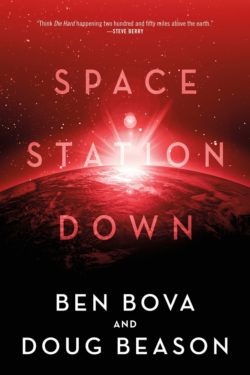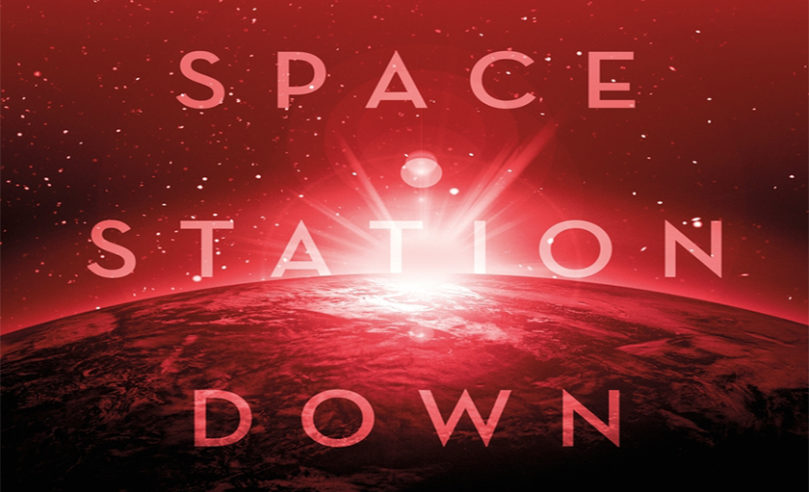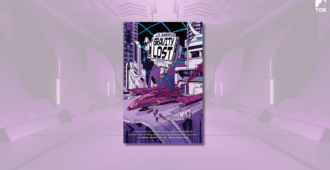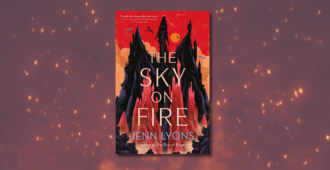 Hugo Award-winning author Ben Bova joins forces with Nebula Award finalist Doug Beason for an action packed technothriller with Space Station Down.
Hugo Award-winning author Ben Bova joins forces with Nebula Award finalist Doug Beason for an action packed technothriller with Space Station Down.
“Think Die Hard happening two hundred and fifty miles above the earth…Will have you watching the skies overhead much more closely.”—Steve Berry
When an ultra-rich space tourist visits the orbiting International Space Station, NASA expects a $100 million win-win: his visit will bring in much needed funding and publicity. But the tourist venture turns into a scheme of terror. Together with an extremist cosmonaut, the tourist slaughters all the astronauts on board the million-pound ISS—and prepares to crash it into New York City at 17,500 miles an hour, causing more devastation than a hundred atomic bombs. In doing so, they hope to annihilate the world’s financial system.
All that stands between them and their deadly goal is the lone survivor aboard the ISS, Kimberly Hasid-Robinson, a newly divorced astronaut who has barricaded herself in a secure area.
Please enjoy this excerpt of Space Station Down, available 08/04/20.
JAPANESE MODULE (JPM)
Kimberly Hadid-Robinson floated upside down in the International Space Station’s Japanese module—or JPM, as she and the other astronauts called it.
Her wiry dark hair was frizzed out to the size of a football helmet, but that didn’t matter, she thought. Normally she’d tie it back into a ponytail if there as even the slightest chance that she’d appear on TV. And it didn’t matter if the live broadcast was being streamed down only to the Johnson Space Center, because invariably some PR genius at NASA Headquarters would decide to shoot a portion of the feed to the national news outlets. They loved to show the public that a female astronaut was serving as the senior ranking American on board the ISS—for the same reason that Public Affairs was using one of their up-and-coming women on the ground to narrate today’s docking. The “Voice of NASA” was usually some over-the-hill bureaucrat who should have retired years ago; Kimberly welcomed the young Hispanic addition, a minority like herself.
Kimberly was a slim, slight sylph of a woman with skin the color of burnt almonds, a little snub of a nose, big dark eyes, and a smile that could light up a room. She wasn’t smiling at the moment.
Much as she’d like to be on hand to meet the new arrivals, the experiments running in the JPM demanded Kimberly’s attention far more than greeting the crewmen coming on board.
The JPM was the farthest module from the docking port in the MRM-2, the Russian airlock, where the newbies were arriving. It was only a hundred yards away from the JPM, but she knew she couldn’t leave the module for more than a minute; it wasn’t worth the trouble—or the headache, for that matter—if she left the experiments just to be there to glad-hand the new arrivals.
After all, she reasoned to herself, support for the work we’re doing here on the ISS doesn’t really come from congressional funding: it comes from the public’s interest in what we’re doing, and that means completing the experiments that even high school kids had thought up. They’d won awards to fly their ideas on the ISS without worrying about the PR benefits of greeting another few space travelers who’re about to make a six-month stay on the station. She’d meet them soon enough.
And it wasn’t as if the incoming cosmonaut was a total stranger to the ISS. Kimberly knew that Farid Hazood was a retread, a Kazakhstani who’d flown aboard the station three years ago: one of those foreigners whom the Soviets . . . er, Russians . . . periodically granted a berth in the ISS. For the Kazakhstanis, it was a sort of repayment for allowing the Russian Soyuz and Vostok launchers to continue to lift off from the Baikonur Cosmodrome in Kazakhstan.
It also served a double purpose: the Russians retained a semi-free launch pad that took only thirty days to refurbish after one of their launches, and the Kazakhstanis maintained international stature as a space-faring nation—a pretty exclusive club numbering only 40 of 196 nations worldwide—well worth the payment and cost for both sides.
She’d never met Farid Hazood, and she knew he’d aced his first mission, so it was no surprise he was chosen to fly again. But even with Farid’s experience, Kimberly thought it was a little strange to have the Kazakhstani coming up with a total newbie. It had been three years since Farid had last flown, and a paying space tourist was accompanying him in the approaching Soyuz capsule; the station’s normal crew of six was being augmented for a nine-day period with this “taxi” crew carrying the tourist. At least the Soyuz’s pilot and commander, Colonel Yuri Zel’dovich, was a seasoned longtimer. This would be his fourth flight to the space station, so Farid and the tourist had some solid experience flying them.
But Russians were Russians, and as eagerly learning capitalists they were happy to accept cash from just about anybody. It cost tourists over sixty million dollars a pop for training, launching, and spending a week on board the ISS, where they were exempt from any responsibilities except to sightsee—and spend the rest of their lives back on Earth bragging about the experience.
The Russians were so hungry for cash they’d even flown up three dozen multimission radioisotope thermoelectric generators, or RTGs, for the U.S. on the last Progress resupply mission; they’d temporarily placed them in MRM-1, at the Russian side of the station, until they could be moved outside the ISS during an extravehicular activity, or EVA, and stored at the end of a boom for safety.
The U.S. would never have been able to launch the plutonium RTGs to the ISS, as any mention of radioactivity ignited hysteria—even though the compact nuclear power sources were absolutely necessary for powering the sensors, rovers, and living areas needed for exploring Mars and beyond, where solar panels are impractical. But the Russians didn’t have environmental activists or an independent press to publicize a risky launch; they just didn’t tell anyone, and took NASA’s money without fanfare. So Kimberly had to admit, compared to the sexy role RTGs had in ISS’s next phase in the space program, some of her efforts at advancing humankind’s knowledge had more to do with the public relations side of NASA, looking after zero-gee ant farms, growing larger-than-life asparagus, and measuring the viscosity of weightless Jell-O.
But she kept that gripe to herself. The money they made from launching the RTGs and tourism was of particular interest to the Russians, especially since the U.S. would soon stop paying $82 million apiece for every American astronaut launched in a Russian Soyuz capsule to the ISS. The U.S. hadn’t had a human-rated spacecraft since the Space Shuttle retired, but thank goodness several newly licensed capsules—Boeing’s Starliner and SpaceX’s Dragon—were just coming into service. Kimberly grimaced as she thought of her last return flight in the Soyuz: a horrific four- gee descent that squeezed your guts and usually hit the ground at some isolated farmland in the Kazakhstani wilderness.
If you were lucky.
She never complained about the landings, knowing that one of her more famous fellow astronauts had come down smack in the middle of the Iraq war zone some twenty years earlier.
So while she regretted not being present to meet Farid Hazood and the Qatari tourist, Adama Bakhet, at the docking port, Kimberly told herself she’d make it up soon enough after they’d entered the ISS and started integrating with the crew. Besides, two of the Russians and the other Americans aboard the station couldn’t make the docking, either; Al was manning the control center and Robert was with the Russians, who had just borrowed three of the four JPM laptops and were now readying a pair of EVA suits in the Joint Airlock.
So Kimberly kept one eye on the experiments percolating along, and the other on the webcast video she’d put on her lap- top as the basketball-shaped Soyuz slowly approached the Russian MRM-2 docking compartment, or DC. The capsule floated gently toward the ISS, no faster than one foot per second as the new female “Voice of NASA” spoke quietly over the comm link.
She could see in the background of her laptop’s monitor stars moving slowly, silently across the black infinity of space. Even though she had witnessed dozens of dockings, the scene still made a heart-stopping view: mating with the million-pound ISS while it and the Soyuz capsule both hurtled through space at 17,500 miles per hour brought a lump to her throat. It was an incredible human achievement, accomplished some 250 miles above the Earth’s surface.
Reluctantly, Kimberly turned away from the laptop and peered through the confocal microscope at the crystal she was monitoring. It was visibly growing, slowly but unmistakably, like a diamond glittering in the microscope’s glareless light. Floating in front of the experimental chamber, she was careful to position herself away from the portable microwave projector that was beaming its 98 GHz radiation into the crystal specimen.
The novel experiment was something she’d never expected to come from the Air Force Academy, but with Scott Robinson pushing heaven and earth to overcome the Academy’s trade- school reputation, his alma mater was evolving into a world-class research organization.
Now where did that come from? Kimberly hadn’t thought of Scott in what? Minutes?
Focus on the experiment, she commanded herself. Stop thinking about Scott: you’re divorced, it’s over.
But her ex-husband was CAPCOM today, serving as their astronaut lead at the mission control center, MCC at Houston, commanding the space station’s communications link with the ground. It’s been eighteen months since the divorce, Kimberly told herself, a near eternity in today’s stop-and-shop world of one-relationship-after-another. And besides, his ego was so large it probably filled every corner of the MCC.
Still, she saw Scott’s handsome, smiling face in her mind.
She shook her head to get clear of Scott’s memory and peered through the eyepiece while her right hand delicately adjusted the Helium-Neon Zeeman laser to measure the crystal’s growth. So far, so good. As the scientists had predicted, the 98 GHz waves from the microwave projector actually accelerated the crystal’s growth over what had been measured back on Earth in a one-gee environment. Score one for zero-gee, Kimberly thought. No, better. It was a hat trick: a home run for the science community, the Air Force Academy, and the ISS.
And for Scott Robinson, as well. Scott was the one who put his old alma mater in touch with NASA’s chief scientist and got the experiment onto the ISS.
Enough about Scott! she told herself. She looked over at her laptop and saw that the airlock hatch in the MRM-2 was swinging open. The newbies were arriving.
Floating between the crystal growth experiment and her laptop, Kimberly watched the inner airlock hatch swing open and the jumpsuited body of the Soyuz spacecraft’s commander, Colonel Yuri Zel’dovich, drift slowly into the ISS, headfirst. Smiling broadly, Cosmonaut Ivan Vasilev, the one-man welcoming committee, reached out for his approaching comrade.
Zel’dovich’s shoulder bumped gently against the hatch’s metal framework, making his feet slowly rotate upward in the zero-gee space. Small, vibrating globules of bright red blood pulsed in the air, more of them oozing out from a slashing wound in the colonel’s neck.
His eyes wide with shock, Vasilev grabbed at Zel’dovich’s lifeless body and started yelling hoarsely in Russian while Kimberly watched the scene on her laptop’s screen, frozen with sudden terror. Vasilev grabbed a handhold on the side of the module and pulled forward, toward the hatch.
Kimberly saw a knifelike object—it was actually thicker than a knife and looked as if it had a retractable blade—suddenly fly from the Soyuz and embed itself in Vasilev’s eye with a sickening thud.
The cosmonaut screamed and jerked away, pawing at his face, frantically trying to pull the blade from his eye, his body twisting in the air, spherules of blood spewing from his face.
A blue jumpsuited body shot out of the Soyuz from the airlock, hurtling toward Vasilev. Kimberly recognized the man from the publicity photos and media releases she’d seen: Farid!
She’d never met the Kazakhstani, and from everything she’d heard, three years ago he’d been a valuable member of the ISS crew. She’d been looking forward to getting a computer scientist up to the station, to help reduce her own brutal research schedule. But now, muttering something in a guttural language, Farid reached for Vasilev with outstretched hands and caught the Russian as he was trying to pull the blade from his eye. Farid put a hand to the back of Vasilev’s head and pushed as hard as he could against his chin, snapping his head back. Then he twisted Vasilev’s neck until Kimberly actually heard an audible pop as the spine snapped.
Vasilev went limp. Farid shoved him away. The dead cosmonaut spun slowly in midair and bumped into the metal structure of the compartment as he floated inertly in zero-gee.
In the Japanese module, Kimberly tightly grasped the hand-hold she’d been clinging to, too shocked to react to the murders she had just seen. As she started to unconsciously rotate around, her free hand suddenly felt an incredible searing pain, as though the hottest oven in the world had just opened in front of her and she’d stuck her hand smack into its middle. She jerked her hand back. The 98 GHz microwave beam, she realized. Even though her skin wasn’t even reddened, it hurt like hell. No wonder some Academy geeks were working on developing such microwaves to protect embassies overseas.
Wringing her hand in pain, Kimberly saw a second person emerging from the Soyuz airlock, wearing a blue jumpsuit identical to Farid’s. She recognized Adama Bakhet, the Qatari tourist. Bakhet floated out slowly, hesitantly, taking his time, obviously quite new to zero-gee.
Kimberly remembered watching a video about the young billionaire tourist from Qatar. He’d paid $60 million for the opportunity to stay aboard the ISS for nine days. But she didn’t focus on him. He was a newbie, and as a tourist he might not even adapt to the station’s zero-gee environment before it was time for him to leave.
To Kimberly, the real threat was Farid.
Farid moved out of the monitor’s view, disappeared from the screen. Where’s he heading? What was he going to do?
Kimberly jerked forward and slapped a hand on the emergency alert button on the caution and warning panel. Klaxons started blaring all through the station. The signal should not only get everyone’s attention, but the crew should rush to their emergency stations. Farid and the fake tourist would hear it, too, and know that they’d lost the element of surprise.
Gingerly, her hand still throbbing from its exposure to the microwave beam, she jabbed at the monitor control, her feet rotating in midair as she moved. In addition to warning the two Russians and the American in the Joint Airlock, she needed to quickly alert Al Sweeting to what she’d just seen. Al was one of her American colleagues who was manning the station’s control center, next door to the Russian SM module, during the docking. Unless he’d been watching the docking he wouldn’t know what had just happened.
Farid was probably heading for Al. Kimberly’s fingers flew over the controls and the monitor blinked and switched to Central Post. She turned up the volume—
And she saw Al and Farid grappling in the zero-gee compartment, rotating around in the air, bouncing off the metal shelving, monitors, computers, and white-sided insulation as they clawed at each other.
I’ve got to do something! Kimberly knew. But what? NASA couldn’t even help, as this view was internal to the ISS, and not being broadcast.
The SM was at the far end of the ISS, and the Russians or the remaining American should be able to get to it faster than she could. Still, Kimberly couldn’t just stay in the JPM and watch. She flicked her eyes from the monitor to the array of white cloth bags Velcroed to the compartment’s wall; they held tools and equipment that she might be able to grab and use.
With the Klaxon continuing to hoot throughout the station, she turned back to the laptop’s monitor, her breath quickening as she watched Al and Farid battling. Al fought furiously, arms pummeling wildly, but Farid was bigger, more solidly built, obviously more experienced.
A scientist like Kimberly herself, Al was small in stature and had a feral appearance: the other astronauts called him Rat, al- though Kimberly kept their relationship strictly professional and always referred to him as Al.
But that didn’t do anything to help Al now.
Farid was holding Al in a choke hold with his left arm. Kimberly could see the dark hair on his wrist in the high-resolution clarity of the laptop’s monitor. His arms bulged in his cosmonaut’s blue uniform. It looked as though the man had spent the three years since his last ISS mission lifting weights and working out. This certainly wasn’t the quiet Kazakhstani that the psychological profilers had analyzed. Had he undergone some sort of physical training for this radically different behavior?
As they gyrated in zero gravity, Farid twisted Al to the left and brought his right hand up and placed it against the back of Al’s head.
Al’s face turned beet red as he struggled for breath. Gasping, he used both hands to try to pry Farid’s massive left arm off his throat. He thrashed and kicked with both his legs, jerking violently back and forth, desperately trying to work free. The two started rotating in midair, bouncing off the consoles. Just as they floated out of sight of the video, Farid viciously twisted Al’s neck . . . and he went limp.
Kimberly pounded at the comm link to NASA, wanting to make sure that the ground was aware of what was happening. How much had they seen? They should have seen Colonel Zel’dovich’s dead body floating from the Soyuz and Vasilev being murdered, but they hadn’t responded in any way. She was sure they were shocked, probably too stunned to respond. She knew they wouldn’t be able to do anything from the ground to help her at this moment, but they had access to the most creative minds in the world: somebody should be able to come up with a workable countermeasure.
But Kimberly realized that at this moment it was up to her, the two Russians, and one other American. They couldn’t rely on NASA to do anything in the station that they couldn’t do for themselves.
The comm link to NASA Headquarters was out, she realized. Not responding. Then she remembered that the link had been working just moments before, when Scott’s voice had been broadcasting over the monitor in his official duty as today’s CAPCOM while the Soyuz had docked.
She knew that the feed was being sent out over NASA TV, and in addition to being picked up by the Russian space program, every major network and news channel back on Earth would have someone watching the feed, even if it was only a lowly summer intern. Their only job was to watch for anything that might occur aboard the ISS that might be worthy of shooting to the newsroom—or even breaking into their regularly scheduled broadcast, if it was important enough.
None of the big guys wanted to be scooped with breaking news by their competitors. Being first meant being able to charge more for commercial airtime, and that meant more bucks. Which was the real name of the game, not news just for the altruistic sake of news.
Kimberly quickly ran through the alternate links emanating from the ISS. One after another they showed that nothing was being transmitted or received. Running her fingers over the touchscreen, she called up the backup satellite-to-satellite relay. That too was dead.
This wasn’t just a technical malfunction; it was a deliberate severing of the entire station-to-ground communication links.
She felt her pulse racing faster, her heart beating so hard it seemed to be trying to burst out of her ribs. Farid. He must have cut the links. He was a computer scientist; he knew exactly how to do it. With his past six-month tour on the ISS he had more than enough experience to control the entire station.
Looking around the crowded compartment, Kimberly kicked out and shot through the air, reaching for one of the white cloth bags secured to the JPM wall that held a potpourri of tools. Her feet glided upward as she grabbed the bag and unfastened its Velcro strap. Fumbling inside, she pulled out two foot-long wrenches and an oversized screwdriver.
Guns were prohibited aboard the ISS. The purpose was to prevent any violence that might occur from people crowded together in an inescapable environment for months—even years—at a time. Bullets would only punch holes in the station’s thin aluminum siding, letting the air escape and killing everyone inside.
For the same reason the Russians had decreed that knives were not allowed on the ISS either, although Kimberly knew there was an ultrasharp utility knife stowed away in Shep’s toolkit—the grab bag of various odd tools Bill Shepherd had brought up with him when he had served on the ISS. Nobody but Shepherd, a free-spirited ex-Navy SEAL, could have gotten away with such a flouting of the rules. Several crew members had used the knife when they needed it. Nobody complained about it and HQ didn’t know it existed. Kimberly was pretty certain Shep’s bag—and the knife—were still in the JPM where Shepherd had stored it, but she couldn’t find it.
From what she’d just seen, Kimberly wasn’t thinking about using an approved, standardized weapon to defend herself, or following any international rules that had been negotiated and talked to death by chair-bound bureaucrats. These madmen would be coming after her. She was totally focused on survival.
Kimberly knew she didn’t have time for discussions or new age, touchy-feely, get-in-touch-with-your-emotions, hand-holding séances. These bastards were coming for her, and she had to be able to defend herself. They’d already murdered three men; what were they going to do next?
She thought she knew. Farid and his companion were out to kill everyone on the station.
Sooner or later they would come for her. Sooner, she realized. Not later.
She began to tremble. They want to kill me!
But then she remembered her father, all those years ago. And the fear inside her subsided. It did not disappear altogether, but now it was overlaid by an icy, pitiless resolve.
Those murdering sons of bitches, she thought. I’ll kill them.
Both of them. But how?
Copyright © Ben Bova and Doug Beason 2020
Pre-Order Your Copy











